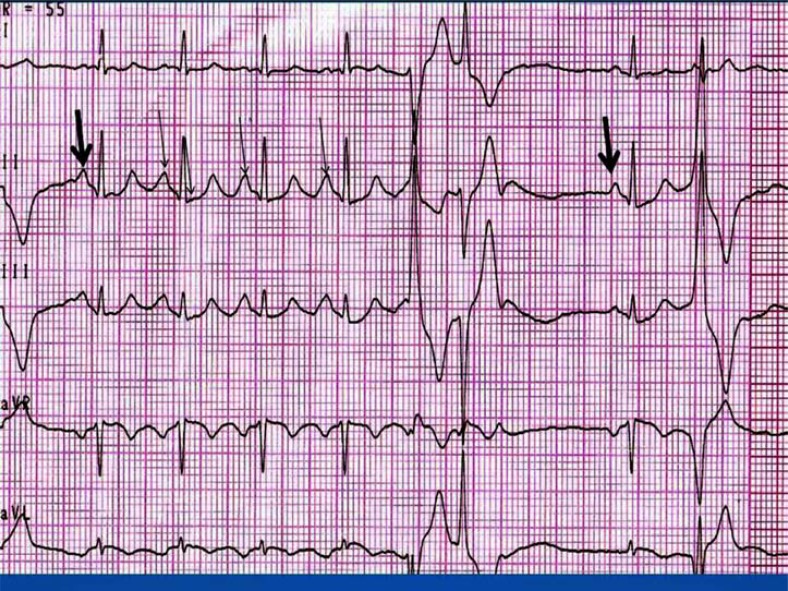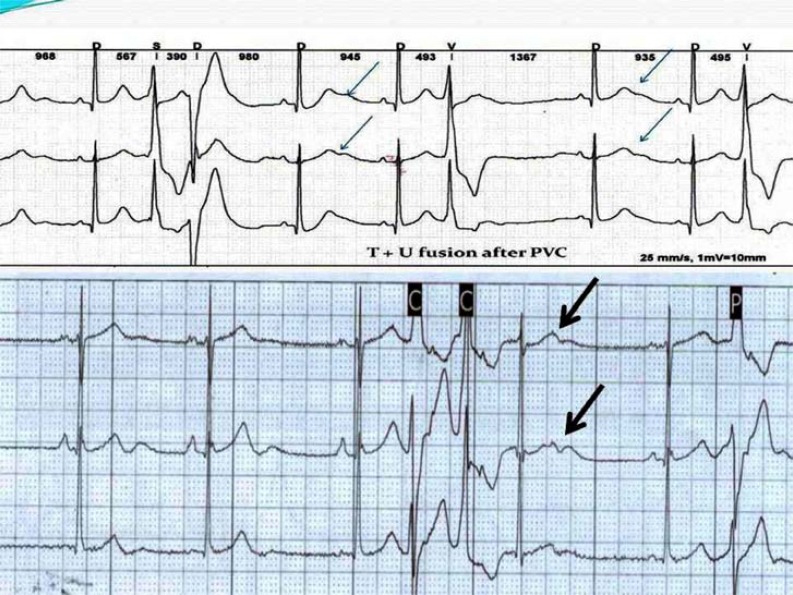Andersen-Tawil syndrome electrocardiogram: Difference between revisions
Jump to navigation
Jump to search
No edit summary |
|||
| (16 intermediate revisions by the same user not shown) | |||
| Line 1: | Line 1: | ||
__NOTOC__ | __NOTOC__ | ||
{{Andersen-Tawil syndrome}} | {{Andersen-Tawil syndrome}} | ||
{{CMG}}; {{AE}} {{ | {{CMG}}; {{AE}} {{VKG}} | ||
== Overview == | == Overview == | ||
An [[The electrocardiogram|ECG]] may be very helpful in the [[diagnosis]] of [[Andersen-Tawil syndrome|Andersen]]-Tawil Syndrome. Findings on an [[The electrocardiogram|ECG]] [[diagnostic]] of [[Andersen-Tawil syndrome|Andersen-Tawil Syndrome]] include a long [[QT interval|QTc]] (LQT) interval, [[U waves]], wide T-U junction and [[T wave|T-waves]]. | |||
== Electrocardiogram == | == Electrocardiogram == | ||
An [[The electrocardiogram|ECG]] may be helpful in the [[diagnosis]] of [[Andersen-Tawil syndrome|Andersen-Tawil Syndrome]]. Findings on an [[The electrocardiogram|ECG]] [[Diagnosis|diagnostic]] of [[Andersen-Tawil syndrome|Andersen-Tawil Syndrome]] include:<ref name="pmid24827800">{{cite journal| author=Kukla P, Biernacka EK, Baranchuk A, Jastrzebski M, Jagodzinska M| title=Electrocardiogram in Andersen-Tawil syndrome. New electrocardiographic criteria for diagnosis of type-1 Andersen-Tawil syndrome. | journal=Curr Cardiol Rev | year= 2014 | volume= 10 | issue= 3 | pages= 222-8 | pmid=24827800 | doi=10.2174/1573403x10666140514102528 | pmc=4040873 | url=https://www.ncbi.nlm.nih.gov/entrez/eutils/elink.fcgi?dbfrom=pubmed&tool=sumsearch.org/cite&retmode=ref&cmd=prlinks&id=24827800 }}</ref> | |||
* [ | * A long [[QT interval|QTc]] (LQT) interval | ||
* T-U patterns which are very characteristic to the syndrome<ref name="pmid15911703">{{cite journal| author=Zhang L, Benson DW, Tristani-Firouzi M, Ptacek LJ, Tawil R, Schwartz PJ | display-authors=etal| title=Electrocardiographic features in Andersen-Tawil syndrome patients with KCNJ2 mutations: characteristic T-U-wave patterns predict the KCNJ2 genotype. | journal=Circulation | year= 2005 | volume= 111 | issue= 21 | pages= 2720-6 | pmid=15911703 | doi=10.1161/CIRCULATIONAHA.104.472498 | pmc= | url=https://www.ncbi.nlm.nih.gov/entrez/eutils/elink.fcgi?dbfrom=pubmed&tool=sumsearch.org/cite&retmode=ref&cmd=prlinks&id=15911703 }}</ref> | |||
* | *Prominent [[U wave|U-wave]] enlargement which are [[biphasic]] in [[limb leads]] | ||
*A wide T-U junction | |||
== | *Prolonged terminal [[T wave|T-wave]] | ||
*[[Premature ventricular contraction|Premature ventricular contractions]] ([[Premature ventricular contraction|PVC]]) especially at '''"rest"''' in Andersen-Tawil syndrome (ATS) patients | |||
**[[Premature ventricular contraction|PVC's]] at rest helps in differentiating ATS from [[catecholaminergic polymorphic ventricular tachycardia]] ([[Catecholaminergic polymorphic ventricular tachycardia|CPVT]]) | |||
* | *[[Polymorphic ventricular tachycardia]] (PMVT) which is called [[Bidirectional Ventricular Tachycardia|bidirectional ventricular tachycardia]] (BiVT)<ref name="pmid11812408">{{cite journal| author=Khan IA| title=Clinical and therapeutic aspects of congenital and acquired long QT syndrome. | journal=Am J Med | year= 2002 | volume= 112 | issue= 1 | pages= 58-66 | pmid=11812408 | doi=10.1016/s0002-9343(01)01011-7 | pmc= | url=https://www.ncbi.nlm.nih.gov/entrez/eutils/elink.fcgi?dbfrom=pubmed&tool=sumsearch.org/cite&retmode=ref&cmd=prlinks&id=11812408 }}</ref><ref name="pmid11233951">{{cite journal| author=Passman R, Kadish A| title=Polymorphic ventricular tachycardia, long Q-T syndrome, and torsades de pointes. | journal=Med Clin North Am | year= 2001 | volume= 85 | issue= 2 | pages= 321-41 | pmid=11233951 | doi=10.1016/s0025-7125(05)70318-7 | pmc= | url=https://www.ncbi.nlm.nih.gov/entrez/eutils/elink.fcgi?dbfrom=pubmed&tool=sumsearch.org/cite&retmode=ref&cmd=prlinks&id=11233951 }}</ref> | ||
**PMVT is defined as when the beats are more than 100/min with variation in QRS axis. | |||
* Prolonged terminal T wave | *In [[Andersen-Tawil syndrome|ATS]] when the patient deteriorates we can see [[Ventricular fibrillation|VF]] which can lead to [[sudden death]] | ||
* | |||
* Premature ventricular | |||
* Polymorphic ventricular tachycardia | |||
[[File:ECG in Andersen- Tawil Syndrome.jpg|alt=“U on P” sign and U-wave masquerading P-wave|center|thumb|“U on P” sign (black arrow). “U on P” sign (U-wave masquerading P-wave) ; the P-wave during sinus tachycardia is inscribed on the U-wave of the preceding beat. Case courtesy by Piotr Kukla et al<ref>{{Cite web|url=https://www.ncbi.nlm.nih.gov/pmc/articles/PMC4040873/|title=Electrocardiogram in Andersen-Tawil Syndrome. New Electrocardiographic Criteria for Diagnosis of Type-1 Andersen-Tawil Syndrome|last=|first=|date=|website=|archive-url=|archive-date=|dead-url=|access-date=}}</ref>|788x788px]] | |||
[[File:LQTS pattern in Andersen - Tawil syndrome (ATS).jpg|alt=Pseudo – LQTS pattern|center|thumb|Post- extrasystolic “pseudo – LQTS pattern” (arrows). This is detected in a sinus beat following a PVC. The fusion of T+U-waves can mimic LQTS. This pattern is not observed in the subsequent sinus beats. Case courtesy by Piotr Kukla et al<ref>{{Cite web|url=https://www.ncbi.nlm.nih.gov/pmc/articles/PMC4040873/|title=Electrocardiogram in Andersen-Tawil Syndrome. New Electrocardiographic Criteria for Diagnosis of Type-1 Andersen-Tawil Syndrome|last=|first=|date=|website=|archive-url=|archive-date=|dead-url=|access-date=}}</ref>|793x793px]] | |||
<br /> | |||
[[File:Pseudo “Tee - Pee sign”.jpg|center|thumb|785x785px|Pseudo “Tee - Pee sign” (black arrow). Pseudo “Tee-pee sign” during a PVC, there is a prolongation of the descending limb of the T+U-wave. In ATS1, the QT interval can appeared prolonged and difficult to quantify because of a prominent U-wave. In order to properly determine the QT interval, the tangent technique should be carefully applied.Case courtesy by Piotr Kukla et al<ref>{{Cite web|url=https://www.ncbi.nlm.nih.gov/pmc/articles/PMC4040873/|title=Electrocardiogram in Andersen-Tawil Syndrome. New Electrocardiographic Criteria for Diagnosis of Type-1 Andersen-Tawil Syndrome|last=|first=|date=|website=|archive-url=|archive-date=|dead-url=|access-date=}}</ref>]] | |||
<br /> | |||
==References== | ==References== | ||
{{Reflist|2}} | {{Reflist|2}} | ||
| Line 37: | Line 30: | ||
{{WikiDoc Help Menu}} | {{WikiDoc Help Menu}} | ||
{{WikiDoc Sources}} | {{WikiDoc Sources}} | ||
[[Category:Electrophysiology]] | [[Category:Electrophysiology]] | ||
[[Category:Disease]] | [[Category:Disease]] | ||
Latest revision as of 17:48, 13 February 2020
|
Andersen-Tawil syndrome Microchapters |
|
Diagnosis |
|---|
|
Treatment |
|
Case Studies |
|
Andersen-Tawil syndrome electrocardiogram On the Web |
|
American Roentgen Ray Society Images of Andersen-Tawil syndrome electrocardiogram |
|
Risk calculators and risk factors for Andersen-Tawil syndrome electrocardiogram |
Editor-In-Chief: C. Michael Gibson, M.S., M.D. [1]; Associate Editor(s)-in-Chief: Vamsikrishna Gunnam M.B.B.S [2]
Overview
An ECG may be very helpful in the diagnosis of Andersen-Tawil Syndrome. Findings on an ECG diagnostic of Andersen-Tawil Syndrome include a long QTc (LQT) interval, U waves, wide T-U junction and T-waves.
Electrocardiogram
An ECG may be helpful in the diagnosis of Andersen-Tawil Syndrome. Findings on an ECG diagnostic of Andersen-Tawil Syndrome include:[1]
- A long QTc (LQT) interval
- T-U patterns which are very characteristic to the syndrome[2]
- Prominent U-wave enlargement which are biphasic in limb leads
- A wide T-U junction
- Prolonged terminal T-wave
- Premature ventricular contractions (PVC) especially at "rest" in Andersen-Tawil syndrome (ATS) patients
- PVC's at rest helps in differentiating ATS from catecholaminergic polymorphic ventricular tachycardia (CPVT)
- Polymorphic ventricular tachycardia (PMVT) which is called bidirectional ventricular tachycardia (BiVT)[3][4]
- PMVT is defined as when the beats are more than 100/min with variation in QRS axis.
- In ATS when the patient deteriorates we can see VF which can lead to sudden death



References
- ↑ Kukla P, Biernacka EK, Baranchuk A, Jastrzebski M, Jagodzinska M (2014). "Electrocardiogram in Andersen-Tawil syndrome. New electrocardiographic criteria for diagnosis of type-1 Andersen-Tawil syndrome". Curr Cardiol Rev. 10 (3): 222–8. doi:10.2174/1573403x10666140514102528. PMC 4040873. PMID 24827800.
- ↑ Zhang L, Benson DW, Tristani-Firouzi M, Ptacek LJ, Tawil R, Schwartz PJ; et al. (2005). "Electrocardiographic features in Andersen-Tawil syndrome patients with KCNJ2 mutations: characteristic T-U-wave patterns predict the KCNJ2 genotype". Circulation. 111 (21): 2720–6. doi:10.1161/CIRCULATIONAHA.104.472498. PMID 15911703.
- ↑ Khan IA (2002). "Clinical and therapeutic aspects of congenital and acquired long QT syndrome". Am J Med. 112 (1): 58–66. doi:10.1016/s0002-9343(01)01011-7. PMID 11812408.
- ↑ Passman R, Kadish A (2001). "Polymorphic ventricular tachycardia, long Q-T syndrome, and torsades de pointes". Med Clin North Am. 85 (2): 321–41. doi:10.1016/s0025-7125(05)70318-7. PMID 11233951.
- ↑ "Electrocardiogram in Andersen-Tawil Syndrome. New Electrocardiographic Criteria for Diagnosis of Type-1 Andersen-Tawil Syndrome".
- ↑ "Electrocardiogram in Andersen-Tawil Syndrome. New Electrocardiographic Criteria for Diagnosis of Type-1 Andersen-Tawil Syndrome".
- ↑ "Electrocardiogram in Andersen-Tawil Syndrome. New Electrocardiographic Criteria for Diagnosis of Type-1 Andersen-Tawil Syndrome".